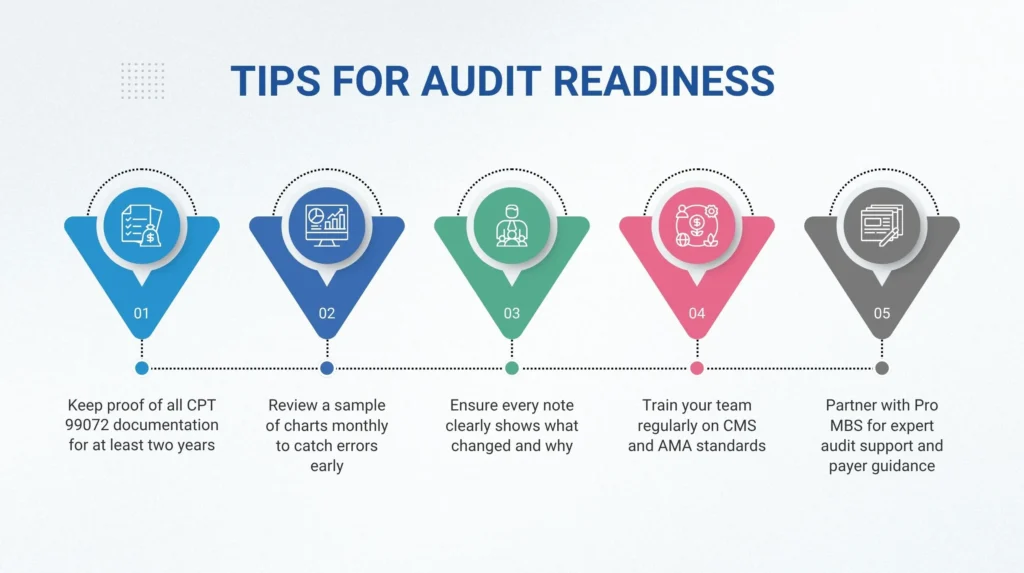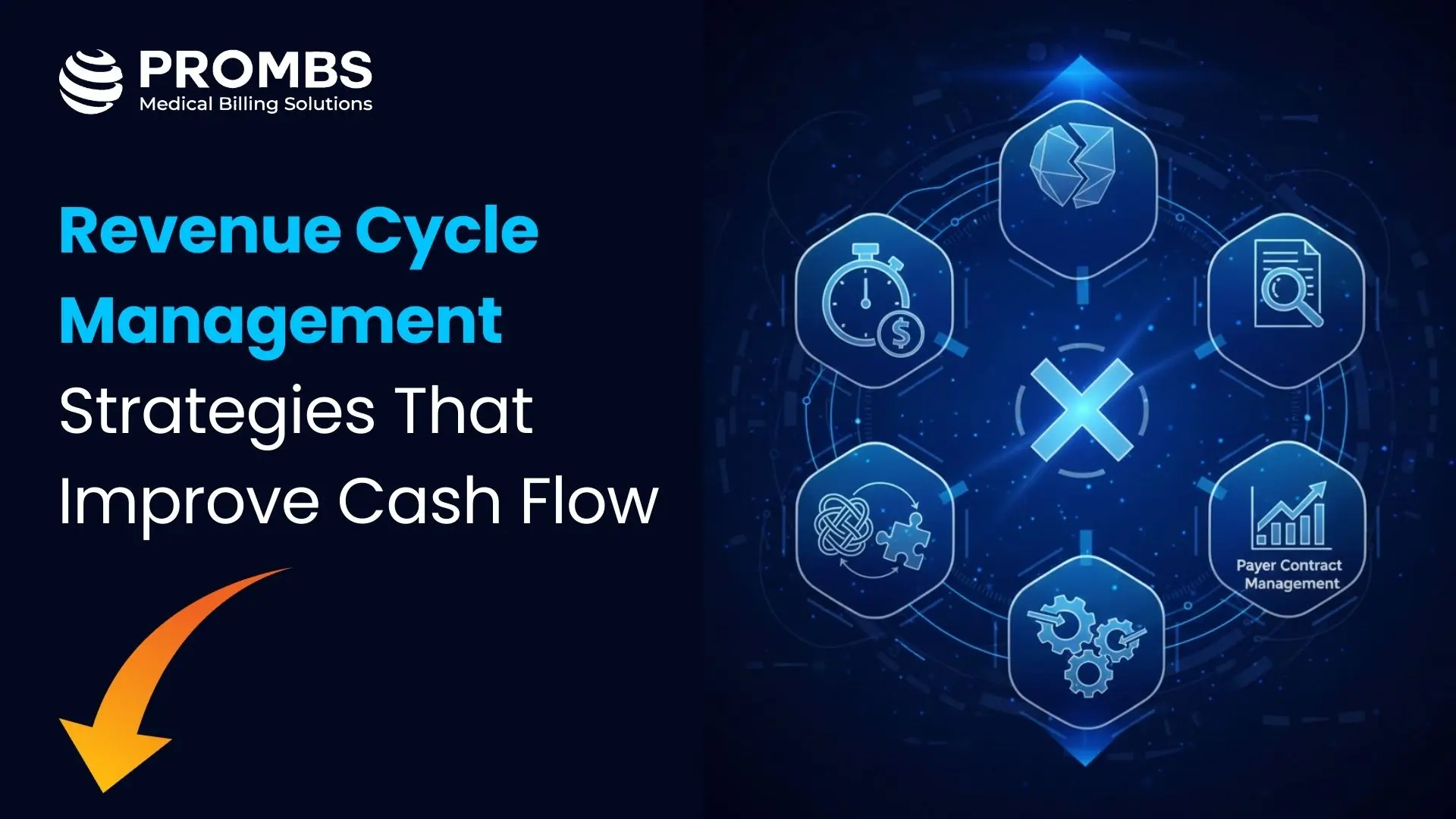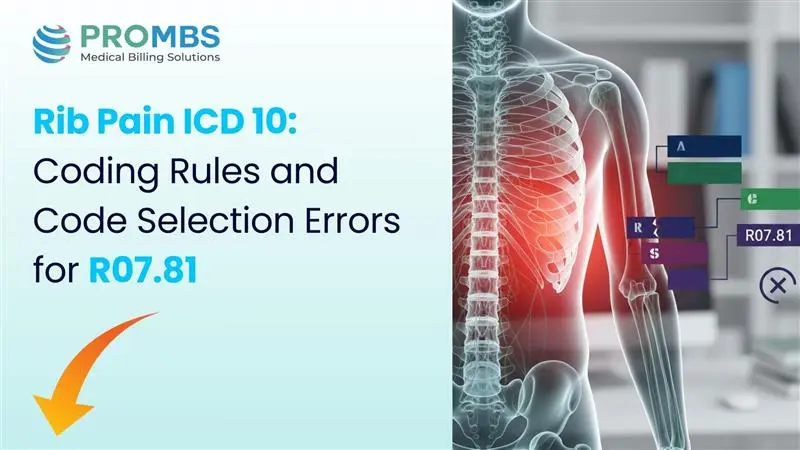CPT 99072 Compliance. The code that looks small but carries big meaning. It stands for every mask, glove, and sanitizing wipe used to keep patients safe. It is not just a billing code. It is proof of care. When the world changed, AMA introduced CPT 99072 to help practices recover new, unexpected costs during public health emergencies.
That purpose has not faded. Many clinics still spend more to protect both staff and patients. Think of all the cleaning supplies, barriers, and extra staff time that never existed before. Those costs add up fast. So how do you stay compliant, bill correctly, and avoid denials? What do payers like CMS actually expect? And what happens if documentation slips through the cracks? This guide breaks everything down. It is clear, structured, and written for practices that care about doing things right. Let us walk through CPT 99072, what it is, how to use it, and how to prove every dollar matters.
What CPT 99072 Covers and When to Use It
CPT 99072 tells the story behind the scenes. It covers extra staff time, supplies, and actions used to protect people during a declared public health emergency. When a national emergency strikes, clinics do not just see patients. They clean every surface. They space out appointments. They add screening time, sanitizing routines, and protective gear. That is the cost this code captures. According to AMA, CPT 99072 is valid only when there is a recognized emergency or when a payer authorizes it under specific conditions. That is key. It is not meant for normal operations. It is for special circumstances where patient safety demands more effort and cost.
You do not replace your regular visit codes. You add CPT 99072 on top. It goes with evaluation and management or procedure codes, not instead of them. Here is a quick example. A patient visits during an emergency period. The provider performs a normal exam but also follows strict sanitization protocols, adds protective equipment, and manages limited waiting room flow. Those actions create cost and staff time beyond standard care. That is where CPT 99072 fits.
Ask yourself these questions every time. Did the appointment require extra safety measures? Was the emergency officially declared? Can you prove those actions took extra time or resources? If all three answers are yes, you are in compliance. CPT 99072 belongs on that claim.
Eligibility and Documentation Requirements
Tie the Encounter to the Emergency
Every CPT 99072 claim must connect directly to an official public health emergency. Start your note with that link. Record the date. Reference the emergency period. Describe what changed in your daily routine because of it. Did your clinic follow new sanitization procedures? Did staff wear new protective gear? Make it clear. When an auditor reads your note, they should see the context instantly. The timeline matters. If the emergency declaration ended, the code no longer applies.
List the Extra Safety Measures
Next, describe the specific steps taken for safety. Mention everything that increased your cost or time. Write what was different from a normal visit. For example, using protective masks, wiping equipment between each patient, or spacing out waiting room appointments. Mention if rooms were cleaned more often or if supplies were replaced between visits. These details make your claim credible. They show a payer exactly why CPT 99072 was justified.
Record Staff Time Accurately
Staff time often decides whether your claim stands or falls. If a nurse or technician spent extra minutes cleaning or managing safety tasks, log it. Note who did the work, how long it took, and why it was needed. A 10 minute cleaning period or a two person screening task may seem small, but it matters. The clearer your time entries, the stronger your proof. CMS expects time to be measurable, not assumed.
Build an EHR Connection
Tell a Complete Story
Did You Know?
CPT 99072 was one of the few codes created directly in response to public health emergencies?
According to AMA, it captures the cost of PPE, cleaning time, and staff effort that traditional E/M codes miss. Using it correctly not only supports reimbursement but also proves compliance when auditors review your patient safety measures.
Payer Rules and Reimbursement Challenges
This is where most practices get tripped up. CPT 99072 is not universally reimbursed. It is recognized everywhere, but not everyone pays for it. CMS generally does not reimburse CPT 99072. They consider the related costs part of regular practice overhead. That means Medicare claims often reject it outright. Commercial payers are different. Some accept it and pay a set amount. Others bundle it automatically. Still others deny it without notice. Medicaid programs vary by state. One state may approve it under emergency extensions, another may quietly phase it out.
So what can you do? Build a payer specific log. List each payer, their policy status, and whether they reimburse CPT 99072. Keep it updated monthly. Always confirm before billing. Contact payer representatives. Document their response. Save those emails. When audits happen, that file becomes gold. Also remember that reimbursement can change without warning.
CMS updates coverage guidance regularly, and commercial insurers follow those trends. Check payer bulletins or newsletters. Staying ahead of those updates saves hours of rework later. When in doubt, treat CPT 99072 as a tracked expense. If denied, appeal with supporting documentation. If bundled, request clarification. The key is persistence. CPT 99072 is about fairness. When used correctly and backed with evidence, it shows that patient safety costs are not invisible.
What Is the Best Way to Avoid Common Billing Mistakes
| Mistake | What Happens | How to Fix It |
|---|---|---|
| Billing after an emergency has ended | Claims get flagged or denied because the emergency period is no longer active. | Verify that the date of service falls within an official or payer approved emergency period before billing. |
| Weak or missing documentation | Notes like “used protective gear” or “extra cleaning” are too vague. Auditors cannot verify them. | Be detailed. Record what supplies were used, who performed the task, and how long it took. Include this in the encounter note. |
| Billing CPT 99072 with CPT 99070 | AMA states these codes cannot appear together. It creates duplication of supply costs. | Use only one code. If CPT 99072 is used, do not bill CPT 99070 for the same encounter. |
| Skipping payer verification | Many assume the code is covered automatically. CMS and private payers vary in acceptance. | Check the payer policy before each submission. Keep a log of payer acceptance or denial for CPT 99072. |
| Incomplete internal review | Errors slip through when staff rush claim submission without a checklist. | Build a short review routine. Confirm emergency status, documentation, payer approval, and absence of conflicting codes. |
Did You Know?
Many multi-specialty clinics lost thousands during the pandemic because they failed to document CPT 99072 properly? CMS data shows that missing documentation was a leading cause of denials tied to this code. Accurate notes turn those missed claims into approved payments and protect your compliance record at the same time.
Leveraging Technology for Real-Time Documentation Consistency In Multi-Specialty
Can technology keep documentation consistent? Absolutely. But only if it works in real time. Modern EHR systems are smarter than ever. They do more than store notes. They think, scan, and flag what is missing before a claim is sent. Unsigned notes? Flagged. Mismatched CPT and ICD-10 codes? Flagged. Incomplete time entries? Flagged again.
CMS’s EHR Incentive Program confirms that automation improves claim accuracy and reduces rework. Technology does not slow you down. It saves you from repeating the same task twice. AI-driven tools now check documentation across every specialty. If a cardiologist forgets to link a diagnosis, the system spots it. If a therapist skips time documentation, it alerts them before the claim moves forward. These systems catch mistakes in seconds, long before they turn into denials. That is how teams stay one step ahead.
How Multi Specialty Practices Should Apply CPT 99072
Multi-specialty groups face unique compliance challenges. Each department adds its own layer of safety expenses. The key is consistency. The same process, the same proof, every time. Here is how to apply CPT 99072 Compliance across different specialties. Every department feels it differently, but the goal stays the same. Keep patients safe. Keep records clean. Keep every action measurable.
- Cardiology: Time matters here. Wipe ECG leads, clean probes, and disinfect treadmill handles after every patient. Log it all.
- Orthopedics: Rooms get messy fast. Track every cleaning between procedures. Note who did it and how long it took.
- Behavioral Health: Record protective gear used for in person therapy and the time spent preparing rooms. Safety counts, even in quiet spaces.
- Pediatrics: Children touch everything. Document every cleaned toy, every wiped table, every replaced supply.
The details differ, but the rule does not change. Document it. Time it. Prove it. Now, keep your workflow tight and your compliance strong. Standardize your documentation. AMA calls for one process for all. Use a single workflow. One language. One format. Use a unified EHR template Add prompts for protective gear, staff time, and cleaning actions. Let the system remind you to record what matters. Train your team often. Short, sharp sessions each month. Update everyone on coding rules and payer changes. Include billing, clinical, and admin staff. Stay connected with payers Know who reimburses CPT 99072 and who does not. Keep that list current and easy to find.
Review your compliance monthly. Check your notes, compare departments, and close any gaps fast. When everyone follows the same rhythm, errors drop. Denials fade. Audit risk falls away. CPT 99072 is not just a billing code. It is a test of how well your practice protects its people and its integrity. Consistency is power. When every specialty uses the same system, denials drop and audit readiness rises. CPT 99072 Compliance reflects how well your practice manages safety, accuracy, and cost control in every department.
CPT 99072 Compliance Checklist
This list is the core of CPT 99072 Compliance. Every item exists for a reason. Each step confirms that your claim reflects real actions, real costs, and real safety measures. Before you bill, pause for a moment. Review every point. Check your notes, your EHR, and your payer rules. If something feels uncertain, fix it before submission.
A complete checklist protects your revenue, your staff, and your reputation. Missing one box can trigger denials or even audits. This is not paperwork. It is your proof of compliance in action. Here is your checklist. Fast, focused, and non-negotiable.
| Requirement | Details | Status |
|---|---|---|
| Payer accepts CPT 99072 | Verified reimbursement policy | ☐ |
| Documentation of added supplies or time | Included in encounter note | ☐ |
| Linked to public health emergency | Confirmed and dated | ☐ |
| Staff time log maintained | Verified | ☐ |
| Not billed with CPT 99070 | Confirmed | ☐ |
| Charge entered correctly in EHR | Verified | ☐ |
Every claim should pass this checklist before submission. If even one box is left blank, stop and investigate. A missed detail can turn into a denied claim or an audit flag. Take a minute to verify each step. Solid proof keeps your billing clean and your compliance record strong.
Tips for Audit Readines
Auditors do not want stories. They want structure. To stay audit ready, keep documentation easy to follow. Each CPT 99072 claim should show what changed, why it mattered, and who did it. CMS recommends keeping supporting materials for at least two years. That includes payer correspondence, denial letters, and notes tied to the claim. Store these securely. Digital copies are fine, but they must be easy to retrieve.
Conduct internal reviews monthly. Pick a small sample of charts, verify documentation, and check payer response. This proactive habit keeps your compliance culture sharp. AMA also stresses that detailed documentation is your best defense. When your record reflects reality, auditors move on quickly. Partnering with experts can help too. Pro MBS works with multi-specialty practices to align coding and payer rules. They monitor payer updates, train teams, and prepare audit files before issues arise.
The truth is simple. Audit readiness is not about fear. It is about preparation. It is knowing that every note tells the same story your claim does. When that alignment exists, compliance becomes second nature.

Did You Know?
Did you know that consistent use of CPT 99072 Compliance checklists reduces audit risk by over 40 percent? Teams that document staff time and supplies in real time face fewer payer disputes and faster reimbursements. Compliance is not luck. It is built one verified record at a time.
Why You Need Partnering with Pro MBS
Compliance is not a one-time effort. It is a daily habit. A rhythm we live by. That is where we come in. We work beside your team, not above them. We review your coding, your documentation, and your billing patterns to keep every claim airtight. Every note verified. Every audit easy.
We track updates from CMS and AMA so you never fall behind. When payer rules change, we adjust your process fast. You get real time guidance instead of learning through denials. We help you build stronger workflows for codes like CPT 99072. You will know exactly when to bill it, how to document it, and how to prove it when reviewed.
Training is part of our partnership. We teach your team to think like auditors and code with precision. Each session builds confidence, accuracy, and discipline across every department. With Pro MBS, you gain more than compliance. You gain control. Claims move faster. Payments come sooner. Audits cause less stress because your documentation tells the full story. Our goal is simple. We keep your practice compliant, efficient, and profitable while helping you deliver safe, high quality patient care.
Frequently Asked Questions
Are CPT Codes Used for Compliance?
Yes. CPT Codes are the language of evidence. They capture each act of care with accuracy and intent. CPT 99072 Compliance records the unseen costs of safety gloves, masks, and time spent protecting patients. At Pro-MBS, we make those details count, turning each entry into proof that your clinic stands ready for any audit.
What are the 5 Steps to Compliance?
Document clearly. Verify every payer rule. Train your team well. Audit your records often. Partner with experts who never miss a step. That is the rhythm of CPT 99072 Compliance. Each action keeps your process clean and your claims protected. Pro-MBS stands beside you through each phase, sharpening accuracy and preserving every dollar you earn.
What are the 7 Pillars of Compliance?
Policies. Training. Communication. Monitoring. Enforcement. Response. Improvement. Seven foundations that keep CPT 99072 Compliance unshakable. They turn billing into structure and documentation into armor. Pro-MBS builds these pillars into your workflow so your practice remains stable, compliant, and strong under review.
What is the Purpose of Using CPT Codes?
CPT Codes define care in measurable form. CPT 99072 gives voice to safety actions that often go unseen sanitizing, screening, and protective steps that keep patients secure. They translate effort into recognized value. With Pro-MBS, your coding tells the full story, clear and defensible before every payer.
What is the CPT Code for Non-Compliance?
None exists. Non-compliance means absence of proof. Misused or missing CPT 99072 invites denials and audits. Pro-MBS ensures every claim leaves your system complete, compliant, and protected against the cost of silence.
What is the Diagnosis Code for Noncompliance?
The ICD-10 Z91.19 series shows when a patient does not follow medical advice. When used beside CPT 99072 Compliance, it paints a full picture of care, risk, and responsibility. Pro-MBS trains your team to apply both accurately so that no detail escapes payer scrutiny.
What are 5 Common CPT Codes?
99213 for office visits. 93000 for ECGs. 36415 for blood draws. 81002 for urinalysis. CPT 99072 for safety and practice expenses. Each one carries precision, each one demands proof. Together they build the foundation of compliant billing. Pro-MBS helps you master every code and keep your claims clean from the first entry to final payment.



